History: Yekdem Support Mechanism for Renewable Energy
YEKDEM is Renewable Energy Resources Support Scheme to incentivize renewable energy production in Turkey.
The first law related to the promotion of renewables (Law No. 5346) was introduced in 2005. However, this law failed to attract investors to benefit from the support mechanism. Thus, the Turkish government decided to change it by passing amending Law No. 6094 in 2011.
From 2015 to 2011, renewable generators were not required to participate in the support scheme. They were free to sell their energy in the market through bilateral contracts. Suppliers were obliged to purchase renewable generation in the market. The price for the RES-certified electricity within each calendar year was formulated as the average wholesale electricity price in the previous year determined by EMRA.
In 2011, a new support mechanism was brought. Apart from earlier legislation, the new mechanism envisioned different feed-in prices for different renewables with an extra support price for domestic equipment use in RES power plants. The guaranteed prices were linked to USD creating a risk to FX rate exposure. The support mechanism was run on a calendar year basis.
Eligible plants increasingly started to approach the mechanism due to two facts:
- the reference electricity prices emerged from the day-ahead market (PTF) stagnated
- US currency started to appreciate against the Turkish Lira. Thus, the spread between the feed-in tariffs and the spot day-ahead prices widened in the course of 2014 and 2015.
The tariffs were established on a yearly basis:
- Participants of the scheme were allowed to sell the electricity to so-called YEKDEM portfolio
- The entire generation counted by their meters was purchased by the system operator at YEKDEM prices leaving the plants without price, volume, and currency risks
- The plants were also exempt from balancing responsibility so were not obliged to forecast their future generation as well
However, later on, 29/04/2016, a new amendment came into force:
- YEKDEM portfolio is abolished
- Eligible plants are expected to sell their generation on the free market, including the bilateral market, the day-ahead market, and the intra-day market
- The spread between the feed-in tariff and the hourly day-ahead market price (which is apparently the PTF) is to be paid to the plants separately (or paid by the plants if PTF>FIT)
- The plants became responsible for balancing thus have to incur costs associated with imbalances
- A tolerance co-efficient is introduced
- Plants are subject to ancillary services requirement
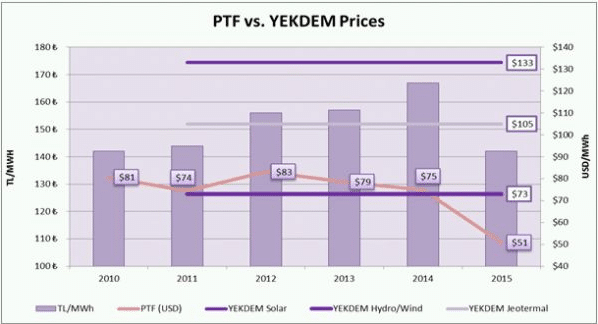
As depicted in the graph, in 2015, the average PTF revolved around US$51, whereas the feed-in tariffs have a constant value of US$73 for hydro and wind and US$133 for solar. The spread represents the extra revenue generated from participating within the YEKDEM portfolio.
On 17th September 2020, the Ministry of Energy and Natural Resources extended the YEKDEM application deadline for another six months. Accordingly, electricity producers can benefit from the YEKDEM scheme if the relevant renewable energy plant enters into service before 30 June 2021. The most significant novelty the Decree brings is basing YEKDEM feed-in tariff payments in TRY, which were previously denominated in USD. Similar to the previous structure, the feed-in tariff prices will vary for different types of renewable energy-based power plants. See the comparison of the old and new Yekdem tariff in the table below.
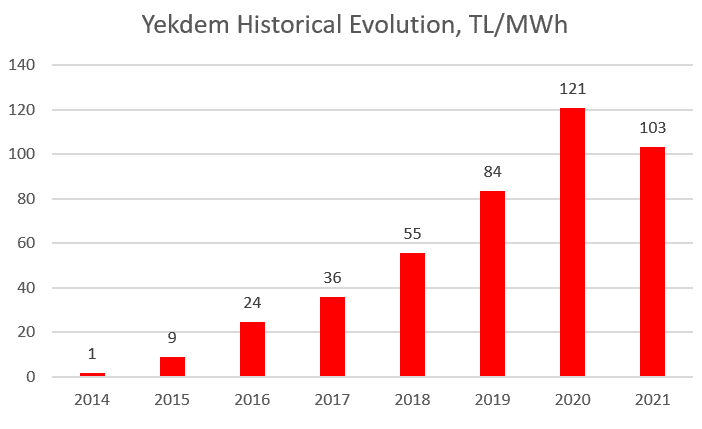
New YEKDEM Feed-in Tariff (Excluding Domestic Components Incentive)

What makes Yekdem cost?
Yekdem cost depends on 3 factors:
- Day-Ahead Market Price, i.e., RES generators are compensated at a strike price, which is set annually – Contract for Difference type of regulatory framework, where the difference between guaranteed tariffs and the day-ahead market is to be paid to the plants or reimbursed back in case PTF>Feed-in tariff
- The International US dollar exchange, i.e., the feed-in tariffs are paid in US currency to RES generators
- Licensed/unsilenced installed capacities participating in the Yekdem scheme, e.g., the amount of renewable generation throughout a year
In simple words, we can say that the higher the day-ahead (spot) market price in Turkey, the lower the Yekdem and vice versa. The weaker the Lira vs. Dollar, the higher Yekdem and vice versa. And the greater amount of renewable generation registered in the Yekdem portfolio, the higher Yekdem and vice versa.
Historically, one of the main reasons for the increasing Yekdem cost was the rising renewable generations, such as Wind and Solar, and the continuous depreciation of the Turkish lira.
The above drivers and how they can impact Yekdem cost are important to understand before we can predict future Yekdem costs for CY2022.
First, let’s start with the day-ahead market and the contract-for-difference (CfD) compensation methodology.
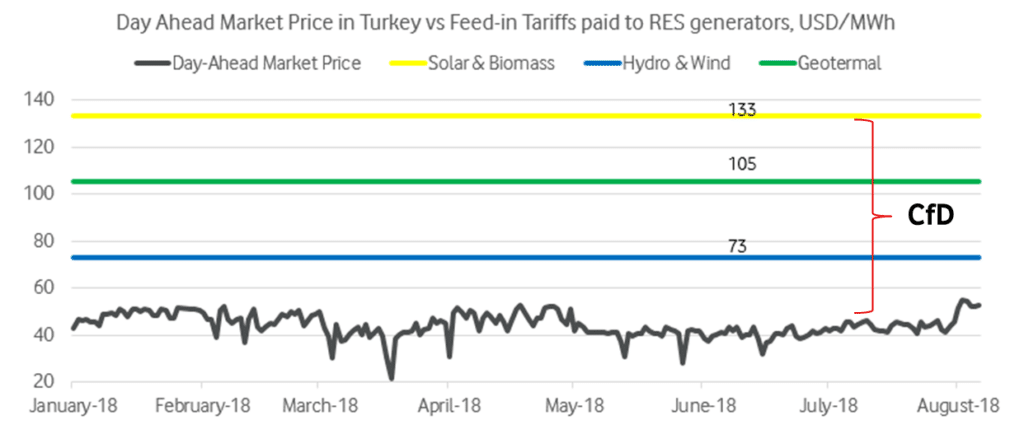
The CfD is the difference between the average day-ahead market and Yekdem tariff that is fixed in USD. Historically, the day-ahead market in Turkey was around 50 $/MWh vs feed-in tariffs of 73 to 133 $/MWh depending on renewable technology. As a result of the price difference, Yekdem’s cost had to be borne by the end-consumers in Turkey to compensate for the investments into renewable power plants.
Since the H2 2021, however, the day-ahead market in Turkey has jumped dramatically due to the high commodity prices and the low gas storage in the country. On top, there was also a sharp drop in hydro generation (down nearly 30%) due to a severe drought in Turkey in 2021, which led to higher demand for more expensive Coal and Gas power generation.
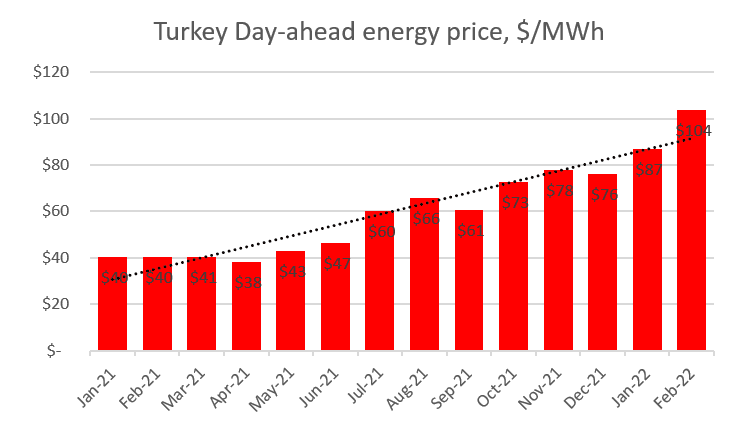
As we can see from the chart above, the day-ahead energy market price in Turkey has increased from the historical 50$ to 75$/MWh from the second half of 2021. This leads to lower Yekdem compensation with this high market prices. For our 2022 Yekdem forecast, we will assume the day-ahead market to be on average 70 $/MWh throughout CY2022.
Second, the international US dollar exchange. The lira has depreciated a lot over the past year.
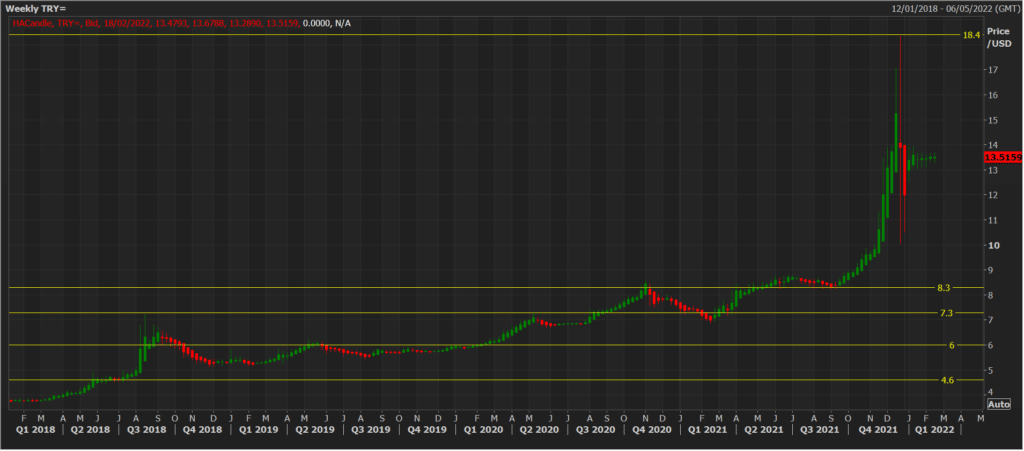
The current exchange rate is around 13.5 Turkish Lira for the dollar. And the rate was around 7.3 a year ago. It means that the Lira has lost almost half of its value against the US dollar.
Finally, let’s talk about increasing renewable capacities in Turkey. As per the final list of power plants registered under the Yekdem support scheme for Calendar Year 2022 published by EPDK, we can observe 2 things:
- The amount of renewable Yekdem capacity increased by 4% in 2022 vs. CY2021 (83 $/MWh)
- The average feed-in remuneration tariff for renewable assets also increased 4% in 2022 vs. CY2021 (86.5 $/MWh)
We also know that the total Yekdem renewable generation was 73 TWh in CY2021. And this includes -30% decline in hydro production. So if we assume that Hydro production in 2022 will recover to somewhere CY2020 levels while the remaining renewable output is increased by 4% in line with the renewable capacity growth, then we can expect around 84 TWh of renewable generation under the Yekdem support in 2022.
2022 Yekdem electricity cost outlook in Turkey
2022 Yekdem forecast by the Turkish government is on average -58 TL/MWh. This would be the first time in history we have noticed negative Yekdem costs. We are going to discuss whether this prediction is possible or not.
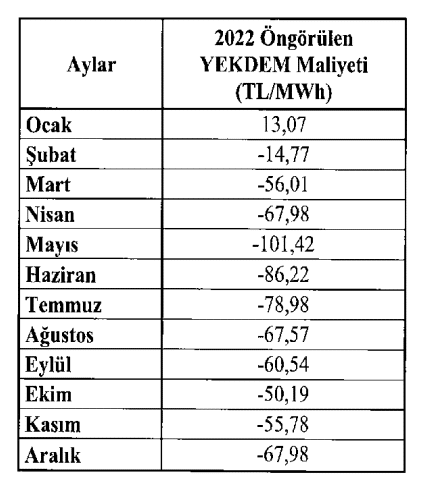
But, first, let’s take a look at the accuracy of the government Yekdem forecast because we already know realized Yekdem costs for Jan’22. Usually, YEKDEM is announced the business day after the 14th at 2-3 pm. The information can be found here. So, the actual Yekdem cost for Jan’22 is 27,5 TL/MWh, which is more than double the government’s forecast. We can draw our conclusions on the accuracy of the Yekdem forecast from here.
Now, it’s time to make our prediction for the cost of Yekdem. It may not be 100% accurate, but it shall give us a high-level estimate of where Yekdem can be in 2022.
We know that the average feed-in tariff across different renewable technologies for the CY2022 Yekdem portfolio is 86.5 $/MWh, while our day-ahead market assumption is 70 $/MWh. So the CfD is 16.5 $/MWh. Then we said that the renewable generation should be 84.000.000 MWh, which is around $1.4bn required Yekdem compensation.
As a comparison, in CY2021, we had a Yekdem CfD of about 28 $/MWh and renewable Yekdem production of 73.000.000 MWh, which is approximately $2bn of Yekdem required compensation to the renewable power plants. And in that year, we know that the average Yekdem cost was 103 TL/MWh. So if we apply the reduction of the Yekdem compensation that is -30% projected YoY decrease (1.4 bn / 2 bn -1) to CY2021 average Yekdem cost of 103 TL/MWh, we shall expect Yekdem of ~72 TL/MWh on average in CY 2022.
That is a big difference when compared to the government forecast of the negative Yekdem -58 TL/MWh in CY 2022. Whether it’s true or not, it’s yet to be seen. We only know that the government’s energy forecasts can’t always be trusted, as proved by history.
If you wish to learn more about energy market dynamics in Turkey, you can read this next article here.
Shall you need energy market advice and/or help with energy procurement and a selection of a reliable electricity service provider in Turkey, you can leave your request via the contact form here.
Curious to learn more about PPAs? Our guide offers a concise roadmap to navigate Power Purchase Agreements (PPAs). Learn more here.









My brother suggested I might like this website.
He was entirely right. This submit truly made my day.
You cann’t imagine simply how so much time I had spent for this information! Thanks!
I’ve read several good stuff here. Definitely price bookmarking for revisiting.
I wonder how a lot attempt you put to make this type of excellent informative
web site.